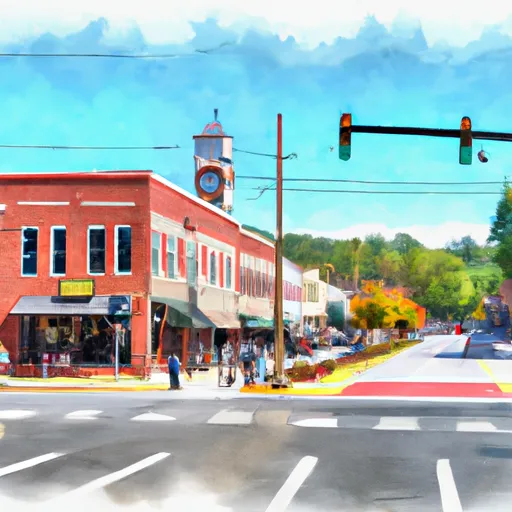-
 Snoflo Premium
Snoflo Premium
Get unlimited access to all our content
With no Ad interruptions! - Start Your Free Trial Login with existing account
Calhoun
Eden Index
Climate
7.9
•
Recreation
3.4
•
Community
2.3
•
Safeguard
4.9/10

Calhoun, Georgia has a humid subtropical climate with hot summers and mild winters. The area receives an average annual rainfall of 52 inches and is located on the Oostanaula River, which eventually flows into the Coosa River. The water quality is monitored by the Georgia Environmental Protection Division, and constituents such as pH, dissolved oxygen, and total dissolved solids are tested regularly. Outdoor recreation opportunities include the Calhoun City Park, which features walking trails, picnic areas, and a playground, as well as the nearby Chattahoochee-Oconee National Forest with opportunities for hiking, camping, and fishing. The area also has several golf courses and is home to the New Echota Historic Site, a former capital of the Cherokee Nation.
What is the Eden Index?
The Snoflo Eden Index serves as a comprehensive rating system for regions, evaluating their desirability through a holistic assessment of climate health, outdoor recreation opportunities, and natural disaster risk, acknowledging the profound impact of these factors on livability and well-being.
Climate Health Indicator (CHI): 7.9
Calhoun receives approximately
1310mm of rain per year,
with humidity levels near 83%
and air temperatures averaging around
16°C.
Calhoun has a plant hardyness factor of
7, meaning
plants and agriculture in this region tend to thrive during the non-winter months.
By considering the ideal temperature range, reliable water supplies, clean air, and stable seasonal rain or snowpacks, the Climate Health Indicator (CHI) underscores the significance of a healthy climate as the foundation for quality living.
A healthy climate is paramount for ensuring a high quality of life and livability in a region, fostering both physical well-being and environmental harmony. This can be characterized by ideal temperatures, reliable access to water supplies, clean air, and consistent seasonal rain or snowpacks.
Weather Forecast
Streamflow Conditions
Coosa-Tallapoosa
Area Rivers
Coosa-Tallapoosa
Snowpack Depths
Coosa-Tallapoosa
Reservoir Storage Capacity
Coosa-Tallapoosa
Groundwater Levels
Recreational Opportunity Index (ROI): 3.4
The Recreational Opportunity Index (ROI) recognizes the value of outdoor recreational options, such as parks, hiking trails, camping sites, and fishing spots, while acknowledging that climate plays a pivotal role in ensuring the comfort and consistency of these experiences.
Access to outdoor recreational opportunities, encompassing activities such as parks, hiking, camping, and fishing, is crucial for overall well-being, and the climate plays a pivotal role in enabling and enhancing these experiences, ensuring that individuals can engage in nature-based activities comfortably and consistently.
Camping Areas
| Campground | Campsites | Reservations | Toilets | Showers | Elevation |
|---|---|---|---|---|---|
| Riverbend County Park | None | 219 ft | |||
| VFW County Park | None | 1,096 ft | |||
| Uchee Creek Military | None | 222 ft | |||
| Chattahoochee Bend State Park | 50 | 928 ft | |||
| Florence Marina State Park | None | 192 ft | |||
| Bluff Creek | 88 | 217 ft | |||
| F.D. Roosevelt State Park | None | 1,272 ft | |||
| Blanton Creek Park | 50 | 561 ft | |||
| McIntosh Reserve Park | None | 715 ft | |||
| Brush Creek County Park | None | 693 ft |
Nearby Ski Areas
Catastrophe Safeguard Index (CSI):
The Catastrophe Safeguard Index (CSI) recognizes that natural disaster risk, encompassing floods, fires, hurricanes, and tornadoes, can drastically affect safety and the overall appeal of an area.
The level of natural disaster risk in a region significantly affects safety and the overall livability, with climate change amplifying these risks by potentially increasing the frequency and intensity of events like floods, fires, hurricanes, and tornadoes, thereby posing substantial challenges to community resilience and well-being.
Community Resilience Indicator (CRI): 2.3
The Community Resilience Indicator (CRI) recognizes that education, healthcare, and socioeconomics are crucial to the well-being of a region. The CRI acknowledges the profound impact of these elements on residents' overall quality of life. By evaluating educational resources, healthcare accessibility, and economic inclusivity, the index captures the essential aspects that contribute to a thriving community, fostering resident satisfaction, equity, and social cohesion.

